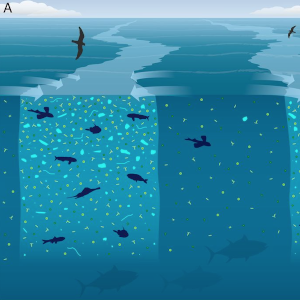Life for many of the world’s marine fish begins at the ocean surface. Ocean conditions dictate food availability and govern survivorship, yet little is known about the habitat preferences of larval fish during this highly vulnerable life-history stage. Here we show that surface slicks, a ubiquitous coastal ocean convergence feature, are important nurseries for larval fish from many ocean habitats at ecosystem scales. Slicks had higher densities of marine phytoplankton (1.7-fold), zooplankton (larval fish prey; 3.7-fold), and larval fish (8.1-fold) than nearby ambient waters across our study region in Hawai‘i. Slicks contained larger, more well-developed individuals with competent swimming abilities compared to ambient waters, suggesting a physiological benefit to increased prey resources. Slicks also disproportionately accumulated prey-size plastics, resulting in a 60-fold higher ratio of plastics to larval fish prey than nearby waters. Dissections of hundreds of larval fish found that 8.6% of individuals in slicks had ingested plastics, a 2.3-fold higher occurrence than larval fish from ambient waters. Plastics were found in 7 of 8 families dissected, including swordfish (Xiphiidae), a commercially targeted species, and flying fish (Exocoetidae), a principal prey item for tuna and seabirds. Scaling up across an ∼1,000 km2 coastal ecosystem in Hawai‘i revealed slicks occupied only 8.3% of ocean surface habitat but contained 42.3% of all neustonic larval fish and 91.8% of all floating plastics. The ingestion of plastics by larval fish could reduce survivorship, compounding threats to fisheries productivity posed by overfishing, climate change, and habitat loss.
Prey-size plastics are invading larval fish nurseries
Publication date
November 11, 2019
Abstract
Journal
Proceedings of the National Academy of Sciences
Region
Hawaii


